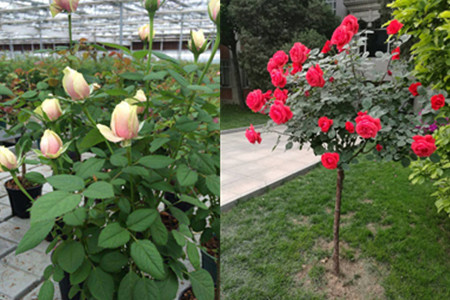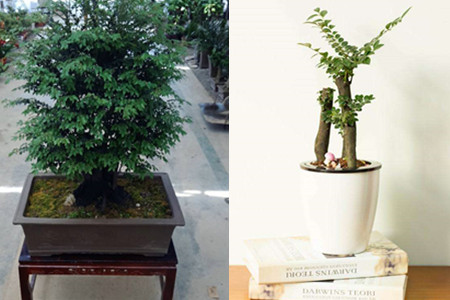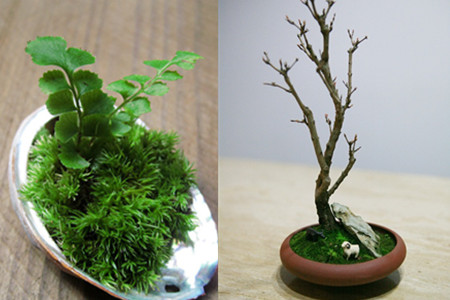What are the points for attention of rose grafted rootstocks?

Rose is a common ornamental flower in the courtyard, and the general varieties are cultivated by grafting. Through grafting, rose branches and leaves can be artificially raised, plants receive sufficient sunlight, and diseases and insect pests are greatly reduced after the improvement of ventilation. The grafted rose trunk has no thorns, so it is easy to watch, and the height and layout of the grafted plants can be controlled according to the form of their own courtyard. The benefits of rose grafting are obvious, so let's talk about what matters need to be paid attention to in rose grafting.
What kind of tree can be grafted with rose?
The principle of grafting between flowers and trees is that the two plants must belong to the same family, and varieties with too great differences cannot survive. The factor affecting the survival rate of rose grafting is the affinity of rose scion and selected rootstock, which is the similarity and similarity of tissue structure and heredity between the two plants.
We all know that rose belongs to Rosaceae, so the rootstocks commonly selected by grafting are wild rose, wood rose, ten sisters, big thorn rose and other varieties, their common characteristics are more developed root system, strong disease resistance, can provide sufficient nutrients for scions.
Second, the right time should be chosen for grafting.
It is well known that air temperature and environment have a great influence on plant growth, and plants are more fragile when grafted, so we should pay more attention to the effects of climate and temperature. The grafting time is generally chosen in spring, when the rootstock has not yet sprouted, or sprouts have not yet grown a large number of leaves. If the timing is chosen too early and the wound heals slowly due to the influence of climate, the weakening of rootstocks too late will lead to death. Generally speaking, it will be carried out in the north of our country in May, and the grafting and cultivation can begin in the south in April.
The choice of scion is also very important, generally choose the annual rose, pick its sunny, well-growing branches as scion.
Third, grafting techniques.
Cut the rootstock horizontally and vertically with a knife to cut twice at the top. The distance between the two knives should be consistent with the diameter of the scion to facilitate the two to fit, and the depth should be cut through the bark to reach the xylem. Peel off the excess bark to reveal the xylem.
Cut the scion obliquely and close the exposed part to the xylem of the rootstock, leaving about three millimeters as a blank, so that the scion can blend better with the rootstock after growth.
Wrap the two grafted plants with a special film for grafting, pay attention to the tightness of the package, too loose is not conducive to plant bonding, too tight will squeeze the scion.
Fourth, how to nurse after grafting.
After grafting, the plant is fragile and easy to infect diseases and insect pests, so pesticide should be sprayed at the interface in time after grafting. Generally, it can survive after ten days of grafting. If there is no sign of survival of the scion after ten days, it is necessary to supplement the grafting.
Scions need more nutrition to help grow after survival, so pay attention to fertilization at this time.
Other matters needing attention.
1. In order to facilitate viewing and management, and to enhance the sun exposure time of the plant, the grafting height is generally between 60 and 80 centimeters, and you can adjust the height appropriately according to the layout of your own courtyard.
2. Three to five rose varieties can be grafted on one rootstock. You can choose your favorite color and pattern to concentrate on one rootstock and fully decorate the courtyard.
3. The length of the scion is about ten centimeters. Pay attention to make sure the incision of the rootstock and scion is smooth when cutting.
4. Check the survival of the grafting for about ten days, gently touch the leaves of the scion, the petiole will fall off is the success of the grafting, not easy to fall, the scion blackens, the hardened is the grafting failure, and needs to be regrafted.
Generally speaking, rose grafting is relatively easy in plant grafting. Yangchun March is a good time for grafting cultivation. Come and have a try.
Culture methods of rootstocks grafted with rose
Rose is known as the queen of flowers, and it is also one of the top ten famous flowers in China. At the same time, it is also one of the main varieties in the production of cut flowers, with large and colorful flowers. There are more than 8000 varieties cultivated all over the world. It is the favorite popular flower in our country. The rootstock selected for grafting rose is Rosa. Cultivate sturdy roses to propagate by cutting.
After years of research and summary of rootstock cultivation, Nanyang Jinpeng Rose Co., Ltd. should pay attention to the following five points:
One is to choose the nursery. Soil is the main environment for the growth and development of seedling roots and the main source of water and nutrients for seedling growth and development. Therefore, the quality of seedling land directly affects the seedling quality, yield and seedling cost, which is the key to the success or failure of seedling cultivation. Rose likes the new stubble sandy loam which is fertile, moist, loose, well drained and free of diseases and insect pests. Therefore, coarse sand, sticky weight, low-lying, continuous cropping and other places should not be selected.
Second, meticulous soil preparation, after the selection of seedling land, deep ploughing was carried out in late autumn and early winter. It requires timely ploughing, leveling, consistent depth, suitable depth, loose and solid, fine crushed soil, and no mixed root gravel.
The third is to apply sufficient basic fertilizer. The application of sufficient basal fertilizer is the premise of cultivating strong rose seedlings, which can not only directly meet the needs of soil nutrients for seedling growth, but also improve soil physical and chemical properties, promote the formation of soil aggregate structure and improve soil microbial activity. it is beneficial to the decomposition of organic matter, thus creating good environmental conditions for the growth and development of seedlings. Fertilization should be mainly organic fertilizer, which can be applied with 5-6m3 per mu, and then shallow ploughing and fine harrowing can be applied to achieve uniform mixing of soil and fertilizer.
The fourth is to build beds. The length of the flat bed is 10-15m, the width of the flat bed is 1m, the length of the high bed is 10-15m, the width of the wound is 60cm, the height is 20-30cm, and the width of the groove is 30cm. No matter the flat bed or the high bed, the bed surface should be flat and uniform, the soil should be broken evenly, and the drainage and irrigation should be convenient.
Fifth, cutting and tending. The cuttings that had been stored and treated in winter were inserted into the seedling bed, or the seedlings rooting by tender wood cuttings were moved into the seedling bed. There is no bed for 2 rows, and the plant is 25cm apart. Water should be irrigated immediately after cutting or transplanting. The ideal rose grafted rootstock seedlings can be cultivated by strengthening the tending management after the seedlings survive.
What are the techniques and methods of rose grafting and matters needing attention? How to cultivate tree-like rose by grafting technique?
Speaking of rose, I believe everyone will be familiar with it. Rose is a common flower that blooms in summer. With its beautiful colors and charming fragrance, it is deeply loved by many flower friends. Today, the editor will introduce to you the techniques and methods of rose grafting and what matters needing attention? How to cultivate tree-like rose by grafting technique?
Cultivation of tree-like rose by secondary grafting
Aristolochia mandshurica with vigorous growth, upright and dry height of about 2m~4m was selected for transplanting. Before transplanting, soil disinfection was carried out in the field and soil pests were killed with Bisumen and carbofuran. During planting, the lower section of Aristolochia mandshurica was soaked with appropriate concentration of chlorothalonil, rooting hormone and other mixed drugs to sterilize and rooting, the upper section was sealed with paraffin, and the upper branches were smeared with Vaseline and hormone mixture to promote lateral sprouting. After planting, the mixture of rooting hormone, plant auxin and lienomycin is used to drip the tree, which is beneficial to the trunk rooting, sprouting, increasing lateral branches and so on. After domestication and cultivation for 1 ~ 2 years, when 3 ~ 5 branches grow at the top and the degree of Lignification is high, it can be used as rootstock.
When grafting, select the stout, disease-free rose branches as scions. For the first time, the rose buds were grafted on the branches of Artemisia mandshurica by bud grafting, and 2 ~ 3 buds were grafted in different directions on each branch separated by 15cm. After the first grafting, strong buds will be sent out from the grafting site and grow into several strong branches, and they will be used as rootstocks for secondary grafting in time when they are not lignified. In the second grafting, the upper part of the strong branch was truncated, the upper part of the strong branch was cut off, and the outer side of the branch was cut longitudinally to the xylem to pry open the cortex; then the rose branch with suitable design and color, sturdy, disease-free and pest-free was selected as the scion, the length of the scion was 15cm, 1 ~ 2 buds were left at the upper end, and the lower sides were cut into a horseshoe-shaped slope respectively. Then insert the lower end of the scion with a large slope facing in and a small slope facing outward, and insert it from the cortex pried open by the rootstock, so that the upper end of the rootstock is slightly white, and then the graft is tightly bound with plastic strips. 2 ~ 3 scions were grafted on the same branch in different directions and bagged in time to keep warm. Seven days later, the cuttings began to germinate, and a year later, the cuttings could blossom and initially form a colorful tree-like rose.
Cultivation of tree rose by one-time grafting
Aristolochia mandshurica, which has a high degree of Lignification, robust, pest-free, 3cm~5cm in diameter and 1m in dry height and 1m in height and 5m in dry height, was cut from two internodes below the tip of the trunk to leave more lateral buds to promote its germination into lateral branches. Transplant in the field and make rootstocks after survival. According to the need of grafting, young or middle-aged plants with good flower color, strong dryness, prosperous growth, many branches and good crown shape, such as tea fragrant rose, abundant flower rose and so on, were selected for grafting, and I branches were used as scions. The branches cut during winter pruning can be stored in sand: the grafting can also be picked as needed, and when the scion needs to be preserved, the scion can be quickly dipped in paraffin liquid to form a very thin wax film on its surface. then put it in a plastic bag and put it in a low-temperature wet place. The grafting time is different in different regions, and the grafting time is also different in different years in the same region due to the influence of climate, which is announced from the first ten days of March to the middle of April when the rootstock sap begins to flow.
The split grafting method can be used for one grafting. First cut vertically in the center of the cross section of the rootstock with a splicing knife, about 3cm~4cm. Both sides of the scion were cut into 3cm~4cm long wedges, leaving 2 ~ 3 buds on it. Pry open the rootstock with a knife and insert the scion and align the rootstock with the scion cambium. If the thickness of the scion is different from that of the rootstock, the outer skin of the scion should be slightly close to the center of the rootstock. The grafting site should be tied up with plastic strips. The same branch is connected with 2 ~ 3 scions in different directions and positions, and the scions should be bagged in time to promote survival.
The method of bud grafting can also be used in one grafting. Select full rose buds as scions, use mangosteen as rootstocks, cut off buds with a blade, leave 5ram distance above and below, cut flat, cut into 45 at the lower end. Bevel. Select thicker branches on the rootstock to cut to the xylem, the size of the section is about the same as the scion, the lower inclination angle coincides with the scion, one side of the cambium should be closely attached, and the clinging film should be cut into long strips and wrapped tightly from bottom to top. The second circle is best covered with the first circle to prevent air leakage; the bud is only covered with one layer, and the top and bottom can be wrapped in several more layers, wrapped tightly, cut off the excess rootstock branches, the cut will be wrapped, watered. The same branch was grafted with 2 ~ 3 buds in different directions and positions. Wipe off the sprouts on the rootstock in time, and after the scions sprout, use toothpicks to open the film to let the buds leak.
Management after grafting
After that, the management of fertilizer and water should be strengthened, and the survival of grafted seedlings should be checked in about 25 days. If the scion has germinated or the scion is bright green, it should be repaired as soon as possible. When the scion is bagged, when the panicle bud grows above 3cm, the bagging can be cut into a small vent to refine the bud, and then the bag can be removed after 5 ~ 7 days; when the panicle bud grows above 10cm, cut the binding strip on one side with a sharp knife and be careful not to hurt the grafted bud. After the ear bud develops into a branch, it should be properly shaped and pruned according to the need to form an ideal tree shape. It should be pruned timely and reasonably after flowering, and should be cut below the third compound leaf of the flower; if there is a new bud under it, it should be cut at the upper part of the robust bud to promote the vigorous growth of the new branch and the early appearance of the bud. Cut fewer strong branches and then cut them; cut more weak branches and cut them first. When pruning, pay attention to retain strong buds: only terminal buds are left after budding, so as to concentrate nutrients to promote large and colorful flowers.
Early summer and midsummer should be properly shaded and sprayed with more water to cool and moisturize, while paying attention to maintaining good ventilation. Pay attention to scientific fertilization. Fertilization is mainly based on base fertilizer, and mature fertilizer mixed with bone powder or hoof can be used; during the growth period, fertilizer can be applied every 10 days or so, and liquid fertilizer diluted with cake fertilizer water, calcium superphosphate or potassium dihydrogen phosphate can be used.
That's all I know about the rose today. I hope it will be helpful for you to read this article. If you want to know more about the rose, please continue to pay attention to the succulent flower bed, we will provide you with more related knowledge!
- Prev

How to raise a few key points of lobular red sandalwood bonsai to raise valuable potted plants
Lobular red sandalwood is a popular quality in the potted plant market at present. It has the advantages of precious wood and fragrant smell. Besides ornamental, it also has the function of repelling evil spirits and improving feng shui. What are the skills of lobular red sandalwood bonsai culture? Let's talk about it in more detail.
- Next

How to make the method of moss coating on bonsai simple and convenient
Bryophytes belong to lower higher plants, with a total of about 23000 species of bryophytes. They do not have flowers or produce seeds, but reproduce through spores, and they can also be used as an indicator of air pollution.
Related
- Fuxing push coffee new agricultural production and marketing class: lack of small-scale processing plants
- Jujube rice field leisure farm deep ploughing Yilan for five years to create a space for organic food and play
- Nongyu Farm-A trial of organic papaya for brave women with advanced technology
- Four points for attention in the prevention and control of diseases and insect pests of edible fungi
- How to add nutrient solution to Edible Fungi
- Is there any good way to control edible fungus mites?
- Open Inoculation Technology of Edible Fungi
- Is there any clever way to use fertilizer for edible fungus in winter?
- What agents are used to kill the pathogens of edible fungi in the mushroom shed?
- Rapid drying of Edible Fungi

